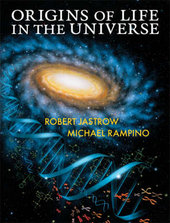
|
Origins of Life in the Universe
Hardback
Main Details
| Title |
Origins of Life in the Universe
|
| Authors and Contributors |
By (author) Robert Jastrow
|
|
By (author) Michael Rampino
|
| Physical Properties |
| Format:Hardback | | Pages:444 | | Dimensions(mm): Height 252,Width 193 |
|
| Category/Genre | Cosmology and the universe |
|---|
| ISBN/Barcode |
9780521825764
|
| Classifications | Dewey:523.1 |
|---|
| Audience | | Tertiary Education (US: College) | |
|---|
| Illustrations |
245 Line drawings, color
|
|
Publishing Details |
| Publisher |
Cambridge University Press
|
| Imprint |
Cambridge University Press
|
| Publication Date |
23 October 2008 |
| Publication Country |
United Kingdom
|
Description
This concise and highly illustrated textbook traces the evolution of the Cosmos from the Big Bang to the development of intelligent life on Earth, conveying clear science in an engaging narrative. By mapping the history of the Universe for introductory science and astrobiology courses for non-science majors, this book allows many of the most fascinating questions in science to be explored. What is the origin of the Universe? How do stars and planets form? How does life begin? How did intelligence arise? Are we alone in the Cosmos? Physics, chemistry, biology, astronomy and geology are combined to create a chronicle of events in which the swirling vapors in the primordial cloud of the Universe evolved over billions of years into conscious life. Outlining, the latest discoveries in astrobiology, this textbook is suffused with the excitement of this fast-moving field. Instructor and student support is provided at www.cambridge.org/jastrow.
Author Biography
Robert Jastrow is well known internationally as an astronomer and author of many widely acclaimed books. His initial research experience was in the field of nuclear physics, and his later work has been in planetary science, atmospheric physics, weather and climate prediction, and application of satellite observations to studies of earth resources. Dr Jastrow joined NASA when it was formed in 1958 and in 1961 set up NASA's Goddard Institute for Space Studies, a U.S. Government laboratory charged with carrying out research in astronomy and planetary science. Michael Rampino is an associate professor of earth science and biology at New York University, and a research associate at GISS in New York. His research spans many areas of the earth sciences, especially the inter-relationships between the Earth's changing environments and the evolution of life. He is Series Co-Editor for the highly acclaimed Encyclopedia of Earth Sciences (Springer) and the Editor-in-Chief of the Earth Science Encyclopedia On-Line.
Reviews'This book is a great introduction to the grand journey of 14 billion years of cosmic evolution from the Big Bang to human evolution! It presents a sweeping synthesis of the sciences ranging from astronomy and astrophysics to planetology, geology, climatology, evolution of life and molecular biology and makes an original and exciting text for a general introductory science course for non-science majors. The text flows smoothly from one topic to another, covering the latest developments in many fields. ... this book has the potential to become a well-received text, and the basis for a popular, exciting science course.' Vivien Gornitz, NASA Goddard Institute for Space Studies 'Extraordinarily well written, a very pleasant learning experience for me ... Jastrow and Rampino have written a remarkable text that should be read by all undergraduates who require a science distributive. Their lucid and entertaining presentation takes the reader through a roller coaster ride covering 14 billion years of cosmic and biological evolution.' Edward Berger, Professor of Biological Sciences, Dartmouth College 'Jastrow and Rampino have managed a tour-de-force - from the origin of the universe to the emergence of life on Earth and the search for extraterrestrial intelligence. Their book makes engaging reading and provides an excellent first overview of this subject for non-specialists.' Christian Koeberl, Professor of Geological Sciences (Geochemistry), University of Vienna
|